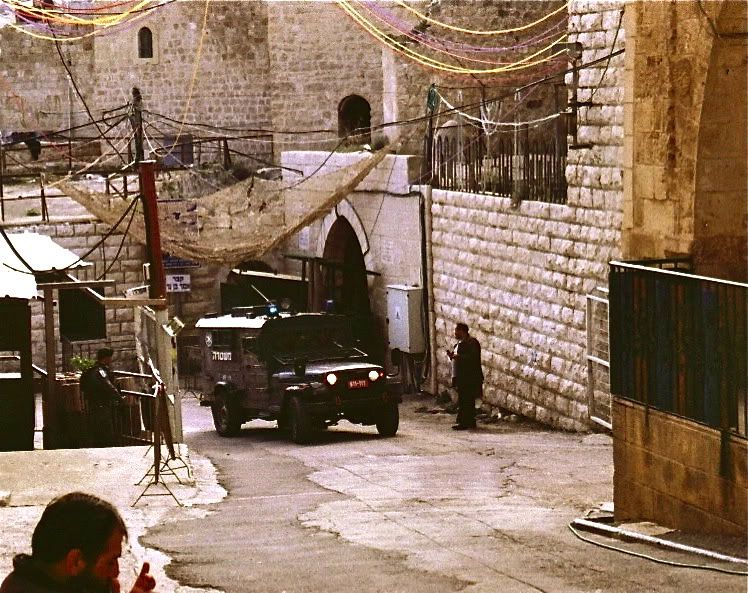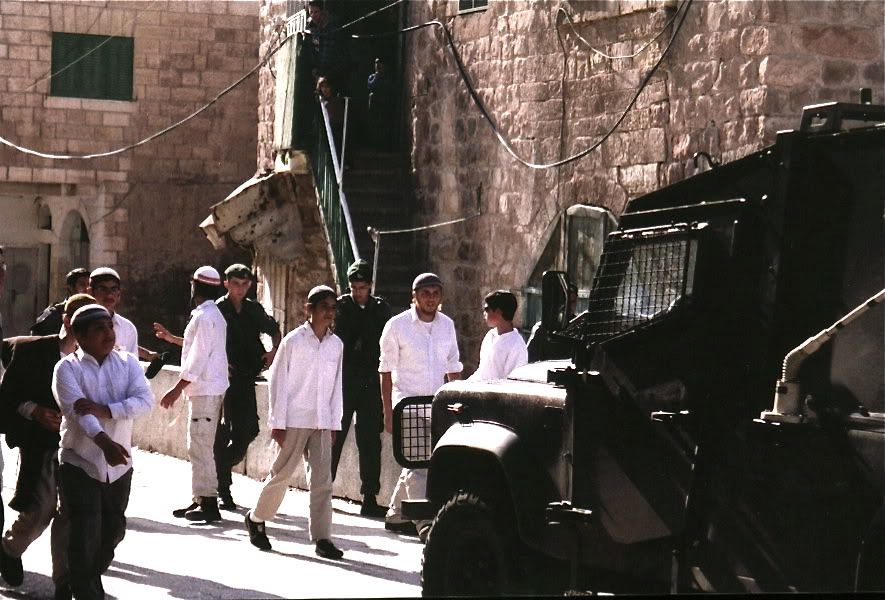
|
|
"The walls of pride are high and wide." {March 29, 2011 , 11:29 AM} I will do my best to jot down some words about Hebron before this week wrenches away the opportunity. Around midday Saturday I set off for Hebron with a fellow intern, Alex, whose command of Arabic and personal charm both greatly exceed my own. "Settlers' Road 60" is the stretch of pavement one follows to reach the city, and in so doing we passed the village of Beit Omer, which is currently seeing both IDF raids and settler violence. We also passed the settlement of Efrata; it's possible that the recent shooters and stabbers trickled out of there, but most people I speak to assume they came from Hebron, where there is no shortage of disagreeable settlers. After inhaling delectable cylinders of shawarma Alex and I made our way from the center of H1, which is under the control of the Palestinian Authority, to the Cave of the Patriarchs, which is guarded by Israeli troops. The transition from the bustling streets of H1 to the ancient Tomb of Abraham felt a bit like leaving a hot, crowded, sweaty party in the living room to visit a sick, frail, pious relative in the attic. (An attic which the guilt-ridden progeny of said ailing relative are desperately trying to renovate.)
While in the Muslim "section" of the Cave—where Dr. Baruch Goldstein sprayed a roomful of worshippers with his M-16 in 1994—I considered how much more keen I might have been to attend mosque as a child rather than church. At the time, my main complaints about the latter were about cold, damp pews and loafers too tight for my feet. Both of those elements are eliminated in the Muslim style: you get a room full of carpets and a no-shoes service. In any event, I think I still would've preferred to be at home watching Thomas the Tank Engine and subsequently end up a heathen. But I suppose we'll never know. Leaving the Patriarchs' lair and entering the streets of H2, I'm sure that Alex and I underwent the same bewilderment as any visitors to Hebron. We had crossed over into the "sterile zone." The barricaded shops, the abandoned schools, and the glares of the settlers (some all too happy to finger the triggers on their chunky firearms) briefly placed us somewhere other than planet Earth. Eight-hundred illegal residents have turned this section of town—population 30,000—into an urban husk. Walking through the crevices of H2 while the sun beat down, I felt like I'd been placed in an ant farm by a kid who forgot to introduce the lively creeps that creepeth.
Living in a void did not appear to bother the settlers I came across. What bothered them a lot was seeing a couple of Westerners socializing with Palestinians—the sight of it turned several smiles into scowls. They must learn to mingle. After a local kid showed us around his neighborhood, Alex and I had tea with a well-dressed, well-spoken shopkeeper named Munir whose company gave me a decent place to start a piece (that I should already be writing) for Isis. In the middle of teatime a brief but noisy fight broke out in front of Munir's shop; an IDF car showed up in the time it took to capture the two photos below. I couldn't tell you what the tussle was about.
Soon after tea we shuffled across town to the checkpoint, back to H1. As so often happens, the wall separating the one section of the city from the other looked ugly and stupid. In making conversation, the Israeli soldiers at the checkpoint asked me what school dances are like back in the States. I said that when you're younger, there's very little dancing and it's not that fun; the kids divide into two large groups, and they don't dare leave their respective corners of the room. But pretty soon they grow up, and they learn to mingle.
Labels: Beit Omer, Cave of Patriarchs, Efrata, Hebron, Ibrahimi Mosque ---------- Post a Comment ---------- |
|
|




